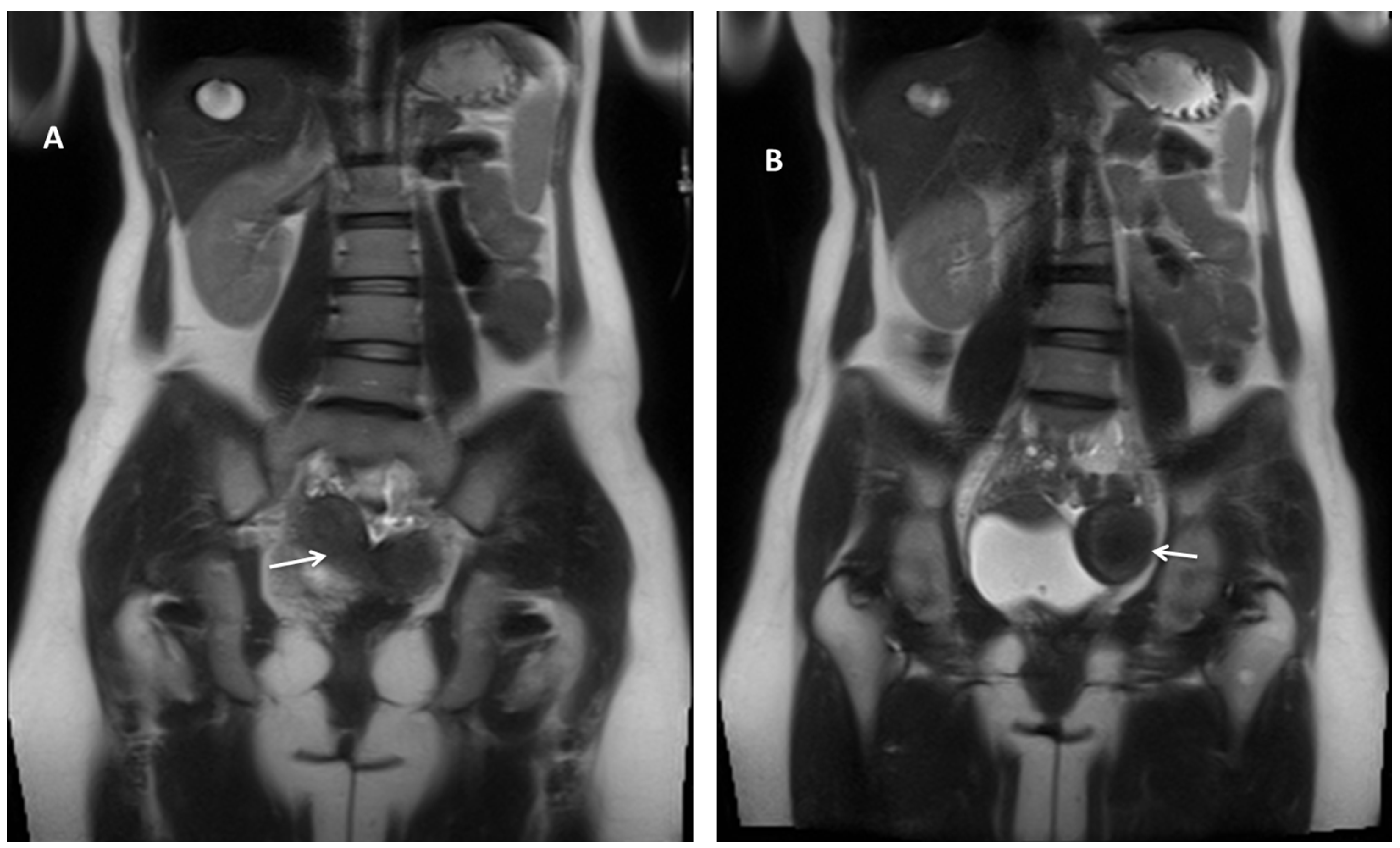Spontaneous Fistula and Abdominal Wall Endometriosis Due to Occult Existence of Unicornuate Right Uterus with Rudimentary Non-Communicating Functioning Left Horn
Abstract
:Author Contributions
Funding
Institutional Review Board Statement
Informed Consent Statement
Data Availability Statement
Conflicts of Interest
References
- Fedele, L.; Marchini, M.; Baglioni, A.; Carinelli, S.; Zamberletti, D.; Candiani, G.B. Endometrium of cavitary rudimentary horns in unicornuate uteri. Obs. Gynecol. 1990, 75 Pt 1, 437–440. [Google Scholar]
- Giampaolino, P.; Zizolfi, B.; Della Corte, L.; Serafino, P.; De Angelis, M.C.; Carugno, J.; Bifulco, G.; Di Spiezio Sardo, A. Unicornuate Uterus with Noncommunicating Rudimentary Horn (Class U4aC0V0/ESHRE/ESGE Classification) and a Communicating Bladder Endometriotic Nodule. J. Minim. Invasive Gynecol. 2022, 29, 816–817. [Google Scholar] [CrossRef] [PubMed]
- Acién, P. Incidence of Müllerian defects in fertile and infertile women. Hum. Reprod. Oxf. Engl. 1997, 12, 1372–1376. [Google Scholar] [CrossRef] [PubMed]
- Donderwinkel, P.F.; Dörr, J.P.; Willemsen, W.N. The unicornuate uterus: Clinical implications. Eur. J. Obs. Gynecol. Reprod. Biol. 1992, 47, 135–139. [Google Scholar] [CrossRef] [PubMed]
- AJalil, R.A.; Alsada, A.I. Unicornuate uterus with a functional non-communicating horn in adolescent. BMJ Case Rep. 2021, 14, e242874. [Google Scholar] [CrossRef] [PubMed]
- Gitas, G.; Eckhoff, K.; Rody, A.; Ertan, A.K.; Baum, S.; Hoffmans, E.; Alkatout, I. An unprecedented occult non-communicating rudimentary uterine horn treated with laparoscopic excision and preservation of both fallopian tubes: A case report and review of the literature. J. Med. Case Rep. 2021, 15, 51. [Google Scholar] [CrossRef] [PubMed]
- Obeidat, R.A.; Aleshawi, A.J.; Tashtush, N.A.; Alsarawi, H. Unicornuate uterus with a rudimentary non-communicating cavitary horn in association with VACTERL association: Case report. BMC Womens Health 2019, 19, 71. [Google Scholar] [CrossRef] [PubMed]
- Grimbizis, G.F.; Gordts, S.; Di Spiezio Sardo, A.; Brucker, S.; De Angelis, C.; Gergolet, M.; Li, T.C.; Tanos, V.; Brölmann, H.; Gianaroli, L.; et al. The ESHRE/ESGE consensus on the classification of female genital tract congenital anomalies. Hum. Reprod. 2013, 28, 2032–2044. [Google Scholar] [CrossRef] [PubMed]
- Pfeifer, S.M.; Attaran, M.; Goldstein, J.; Lindheim, S.R.; Petrozza, J.C.; Rackow, B.W.; Siegelman, E.; Troiano, R.; Winter, T.; Zuckerman, A.; et al. ASRM müllerian anomalies classification 2021. Fertil. Steril. 2021, 116, 1238–1252. [Google Scholar] [CrossRef] [PubMed]
- Tanaka, Y.; Asada, H.; Uchida, H.; Maruyama, T.; Kuji, N.; Sueoka, K.; Yoshimura, Y. Case of iatrogenic dysmenorrhea in non-communicating rudimentary uterine horn and its laparoscopic resection. J. Obs. Gynaecol. Res. 2005, 31, 242–246. [Google Scholar] [CrossRef] [PubMed]
- Thakur, S.; Sood, A.; Sharma, C. Ruptured noncommunicating rudimentary horn pregnancy at 19 weeks with previous cesarean delivery: A case report. Case Rep. Obs. Gynecol. 2012, 2012, 308476. [Google Scholar] [CrossRef] [PubMed]
- Suryawanshi, S.V.; Dwidmuthe, K.S. A Case Report on a Left Unicornuate Uterus with Communicating Right Rudimentary Horn Associated with Hematometra and Hematosalpinx. Cureus 2023, 15, e37959. [Google Scholar] [PubMed]




Disclaimer/Publisher’s Note: The statements, opinions and data contained in all publications are solely those of the individual author(s) and contributor(s) and not of MDPI and/or the editor(s). MDPI and/or the editor(s) disclaim responsibility for any injury to people or property resulting from any ideas, methods, instructions or products referred to in the content. |
© 2024 by the authors. Licensee MDPI, Basel, Switzerland. This article is an open access article distributed under the terms and conditions of the Creative Commons Attribution (CC BY) license (https://creativecommons.org/licenses/by/4.0/).
Share and Cite
Cruciat, G.; Staicu, A.; Florian, A.; Nemeti, G.; Sachelaru, D.; Andras, D.; Muresan, D. Spontaneous Fistula and Abdominal Wall Endometriosis Due to Occult Existence of Unicornuate Right Uterus with Rudimentary Non-Communicating Functioning Left Horn. Diagnostics 2024, 14, 532. https://doi.org/10.3390/diagnostics14050532
Cruciat G, Staicu A, Florian A, Nemeti G, Sachelaru D, Andras D, Muresan D. Spontaneous Fistula and Abdominal Wall Endometriosis Due to Occult Existence of Unicornuate Right Uterus with Rudimentary Non-Communicating Functioning Left Horn. Diagnostics. 2024; 14(5):532. https://doi.org/10.3390/diagnostics14050532
Chicago/Turabian StyleCruciat, Gheorghe, Adelina Staicu, Andreea Florian, Georgiana Nemeti, Diana Sachelaru, David Andras, and Daniel Muresan. 2024. "Spontaneous Fistula and Abdominal Wall Endometriosis Due to Occult Existence of Unicornuate Right Uterus with Rudimentary Non-Communicating Functioning Left Horn" Diagnostics 14, no. 5: 532. https://doi.org/10.3390/diagnostics14050532
APA StyleCruciat, G., Staicu, A., Florian, A., Nemeti, G., Sachelaru, D., Andras, D., & Muresan, D. (2024). Spontaneous Fistula and Abdominal Wall Endometriosis Due to Occult Existence of Unicornuate Right Uterus with Rudimentary Non-Communicating Functioning Left Horn. Diagnostics, 14(5), 532. https://doi.org/10.3390/diagnostics14050532





